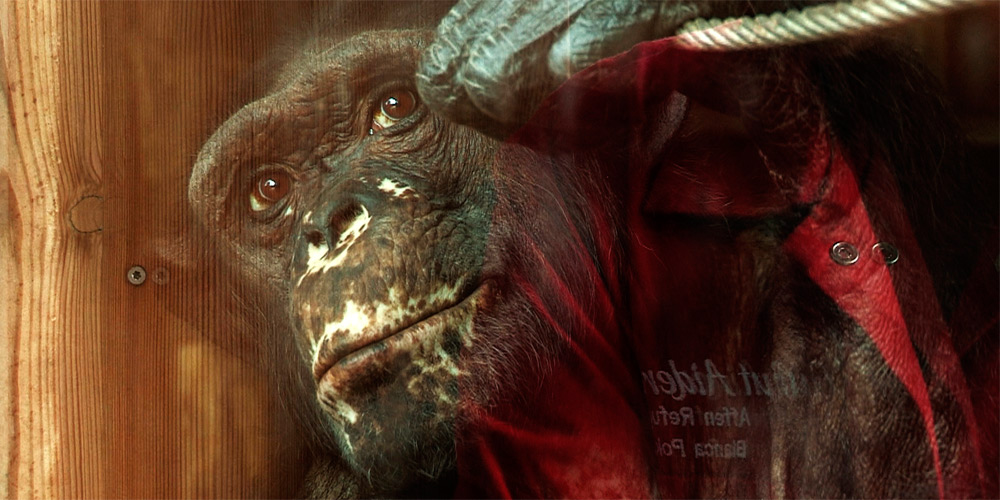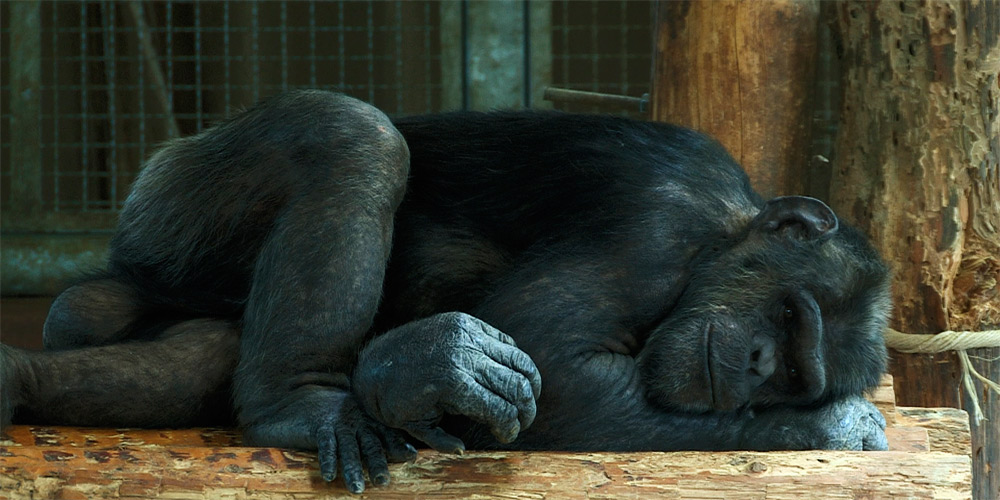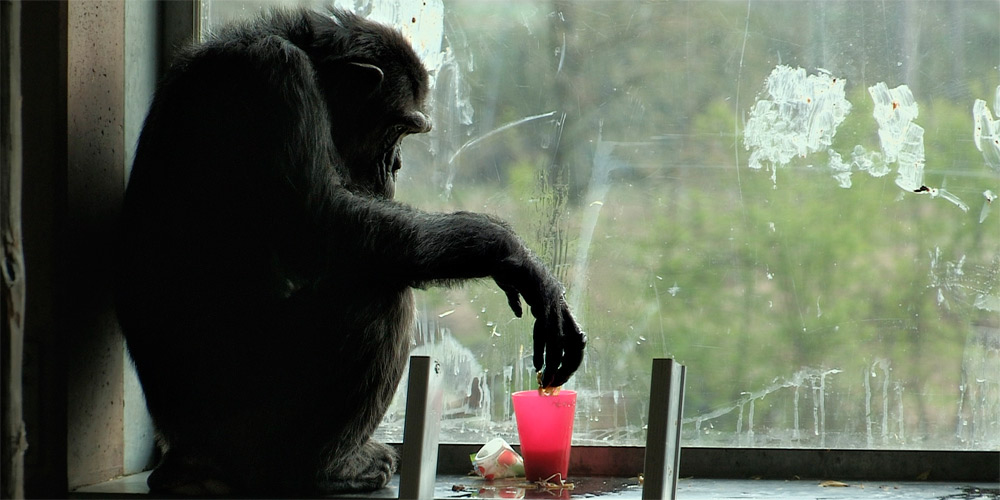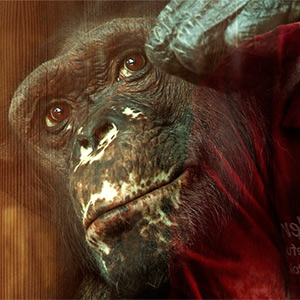40 traumatized chimpanzees previously used as test objects for a pharmaceutical company in a laboratory and infected with HIV and hepatitis viruses are now being cared for in a former safari park near Vienna of four animal keepers. On THU January 16, 2014, 8 PM, filmmaker Christian Rost gives personal insights into this touching story during “Deep Space LIVE“. After presenting his film he will discuss with Gerfried Stocker, artistic director of Ars Electronica, and Dr. Manuel Selg, professor of molecular biology at the University of Applied Sciences Wels University. For the Ars Electronica Blog Christian Rost already answered some questions about the movie before.

Picture credit: DENKmal-Film / WDR / ORF
What feelings and thoughts did you have during the shooting?
The monkeys – after over 30 years of solitary confinement – first had to be socialized very slowly. They were only allowed to meet member of the same species in difficult and dramatic encounters. They “grasp”, in the truest sense of the word, what it means to touch another monkey, to smell and to take him in the arm. In addition, the monkeys have learned what it means to be a “monkey”. Finally they were allowed to move, climb and live in a group. They had to learn to arrange themselves, to argue and to love. Today the monkeys do “politics” all day long. Nothing is more important to them than to see what the others are doing or to intervene, to manipulate, to forge alliances. All this was and is accompanied by four animal keepers. Two of them have already supplied the monkeys in the laboratory.
Thoughts and feelings develop well in advance of the actual shoot. In fact, already in finding the story! As so often it was coincidence here. The specific topics can not search you, they have to fall to you. Issues such as animal welfare or animal experiments had no special priority for me. I told my colleague Claus Strigel (we did not know yet) of the planned outdoor enclosure for traumatized chimpanzees in Gänserndorf. An interesting story for a great reportage. But we discovered layer by layer more material, which promised a really great story. After a first visit to Gänserndorf – an incredibly intense experience with tumult of emotions – we decided to produce the film together.
Behind the news of the “open-air enclosure for traumatized chimpanzees” we discovered on one hand approaches of a crime story about illegal imports and a scandalous solitary confinement in which the chimpanzees were kept by Immuno. On the other hand, we were fascinated by the story of Annemarie and Renate who were able to develop fromm employees for animal experiments to therapists of the tortured chimpanzees within 20 years. Trapped on the other side of the fence and a true heroic story. And behind these two exciting strands major issues of our civilization developed: guilt, responsibility, restitution. Certainly with a question mark, therefore the English title is “Redemption Impossible”.
To tell this major set of issues with an exciting and emotional story, so our thoughts and feelings, is a great chance. So “Redemption Impossible” certainly deals with animal testing and animal welfare, but behind it – I think – there are a lot more and bigger topics.
In fact, we were highly electrified by this story. However, we came across with a hermetic bell of silence. Some who were involved in imports at the political level gave us strictly anonymous careful notes. The sentence “I knew that one day this will come to light” we heard very often. The more grateful we were that the witnesses found the courage to unpack more details – such as Dr. Ulrike Goldschmid, Dr. Daniel Slama or Josef Schmuck. Partially mixed with painful guilt feelings, despite of all efforts not to have prevented the illegal import of chimpanzees. But even with the two animal keepers Renate Foidl and Annemarie Kuti, it took a long time until they were ready to talk about the past. We are incredibly grateful to them for their courage, because even today it is very essential for them to weigh each formulation, because the topic is covered with many formulation commandments and speech prohibitions.

Picture credit: DENKmal-Film / WDR / ORF
In addition to the people we finally were fascinated by the chimpanzees, too. The colleagues are just great! Cunning, smart, charming – as we are. Particularly admirable is their ability – despite of decades of isolation to be able to accept the offers of the encounter and of life in groups. The degree of trauma is of course very different. The worst injured chimpanzees were able to see their whole long life at the laboratory only in “space suits” because of their HIV status. The chimpanzees are not ill due to AIDS, they are “only” virus carriers. Obviously, the limited contact with people in the laboratory itself has helped the non-infected to remain sociable. But it is crucial that even the non-groupable chimpanzees show us that their life is worth living in Gänserndorf. They modestly live with together in contact with human beings – and all got their outdoor enclosure. Also, human beings are smart and amiable … this is quite the complex message of the movie.
Finally, one moment touched us most – as well as all audiences: The moment when the chimps meet for the first time their life outdoors – or not. Because we knew: Here the dream of the animal keepers gets true. We didn’t know what the chimpanzees dreamed about. But it was an incredible effort, a huge investment of Gut Aiderbichl. But what if the chimpanzees only fear the unknown freedom? What if they decide to reject this gift? No one could know what they will decide. Another moment was to look into the eyes of the chimpanzees. Because they also really look back to us. Inviting and repellent. Familiar and different. We felt the one hand, a great relationship and proximity and on the other hand – and at the same time – a constantly irritating strangeness. Where are you? What do you think? We could not look into the soul of the chimpanzees, but sometimes it was as if we had seen an unimaginably deep look into their past. Very strange.
Did the research with the monkeys by the pharmaceutical company actually achieve something? The “meaning” of life – was it worth?
No. When the chimpanzees were illegally detained and transported to Austria in the mid-1980s, the AIDS hysteria in Europe had just reached its first climax. Scientists, governments, distributors. Everyone knew who would now find first a vaccine that one would be the big winner. Concerns have been put on hold. No one took accountability for this. The housing conditions were at the time – so cruel they were – legally. The only possible way to tackle it would have been to accuse the imports by appealing to the CITES agreement. Why this was not ultimately successful, among other things, tells the film.

Picture credit: DENKmal-Film / WDR / ORF
Do you think, images of chimpanzees in laboratories touch us more instead of laboratory mice or even novel and “unnatural” creatures that are created with synthetic biology from scratch?
Basically, the chimpanzee fascinate humans. Just by its prehistory. His relationship to us, his emotional and intellectual similarities. Apes are our closest relatives genetically speaking. They also show behaviors that allow us to recognize them as individuals. I do not know what images touch more. Indeed, chimpanzees have a lobby for some years. For example, the Great Ape Project calls three basic rights for apes: the right of living, the protection of their individual liberty and the prohibition of torture. Currently, a court case is being prepared in the United States to gain personal rights for chimpanzees.
What makes a creature? Is the ape at least persona non grata? Who is included into the group of morally equal? Chimpanzees, gorillas and orang-utans? Bonobos, do not forget! And why not also the same for mice and clones? “Redemption Impossible” asks these questions. And these are no questions for images, but of ethics. The number of experimental animals in the laboratories of the world is increasing year after year. Researchers argue with benefits for the people, critics say that the experiments are unnecessary – as evidenced in the case of the chimpanzees from Gänserndorf! It is certain that a huge industry makes good money. Thus, in 2012 nearly 3.1 million vertebrates were used in animal experiments or other scientific purposes in the German federal states. These are 170,000 animals more than last year and more than over a million as ten years ago.
Anyway, the synthetic creatures are very soon among us. In 2013, two American bioscience companies have applied at the European Patent Office to be able to make genetic modifications on chimpanzees in order to make their immune systems similar to humans. For example, this is one way to “build” suitable monkeys for using them more effective in vaccine research.

Picture credit: DENKmal-Film / WDR / ORF
Science and life – how does they fit together in your opinion?
The one is unthinkable without the other. Science is enlightenment, is inquisitiveness, is civilization. Without science there would be no modern society in its present form. In the positive, and in the negative way. And, science makes mistakes. Especially when ethical principles are negated. If it supports the vanities, the lust for power or profit desire or science spins itself in a self-referential cocoon. The monkeys of Gänserndorf are victims of this form of reckless, irreverent and science which is only obligated to itself. In addition, we enjoy now and then the achievements of science. Claus at the dentist and I, here Loriot must be cited, during flying: “Man is the only creature that can fly while taking a warm meal.”
What reactions did you get after the release of your movie?
The movie triggers discussions. Always new again. Whether in Europe, in the U.S., in South America or Asia. Especially where human and animal rights are not yet part of the public discussion, the film undergoes a great willingness to deal with these issues. “Redemption Impossible” was now shown at over 15 festivals and has received a number of awards.
“Deep Space LIVE: Redemption Impossible” takes place on THU January 16, 2014, 8 PM, together with Christian Rost at the Deep Space of the Ars Electronica Center Linz. German language only.
